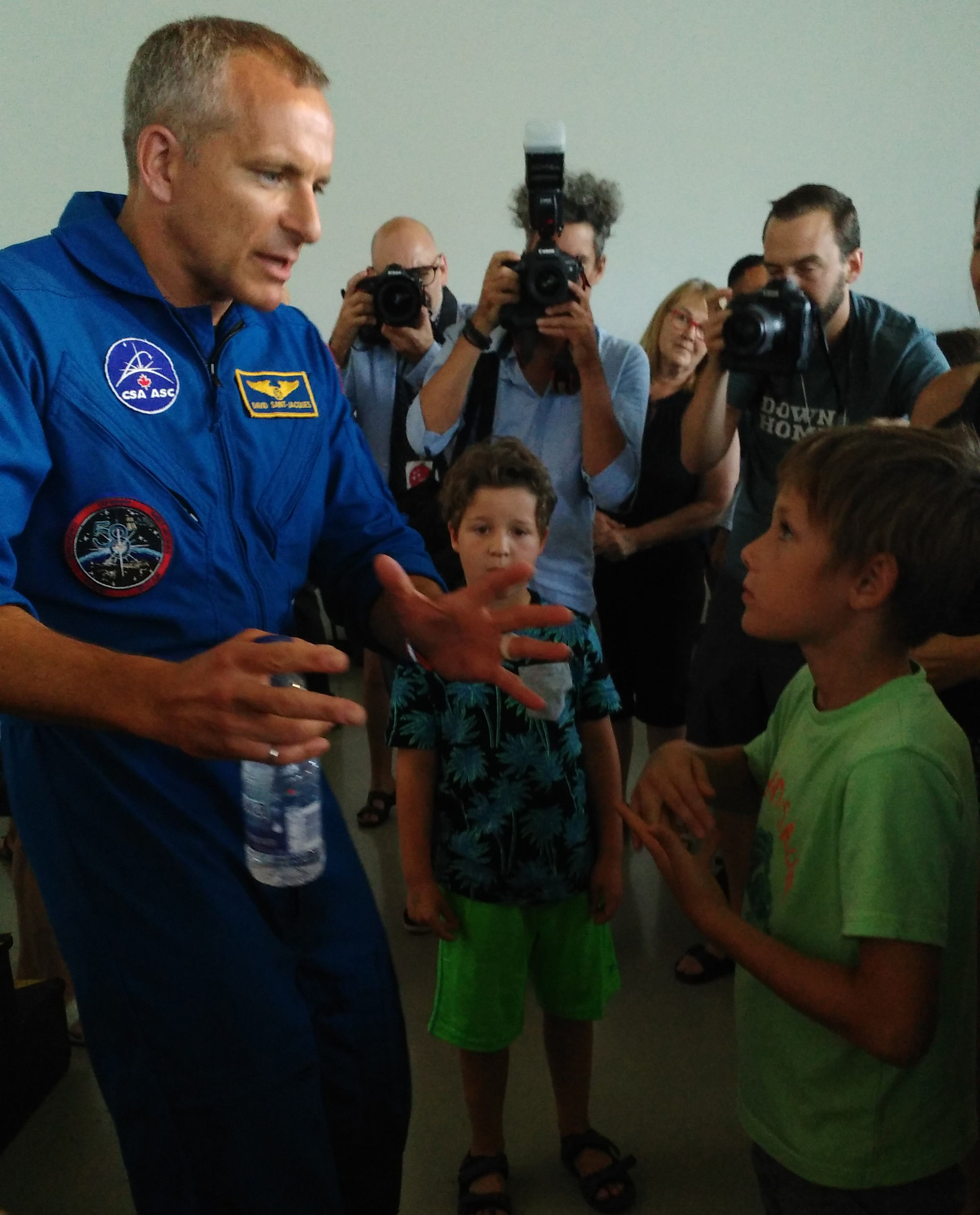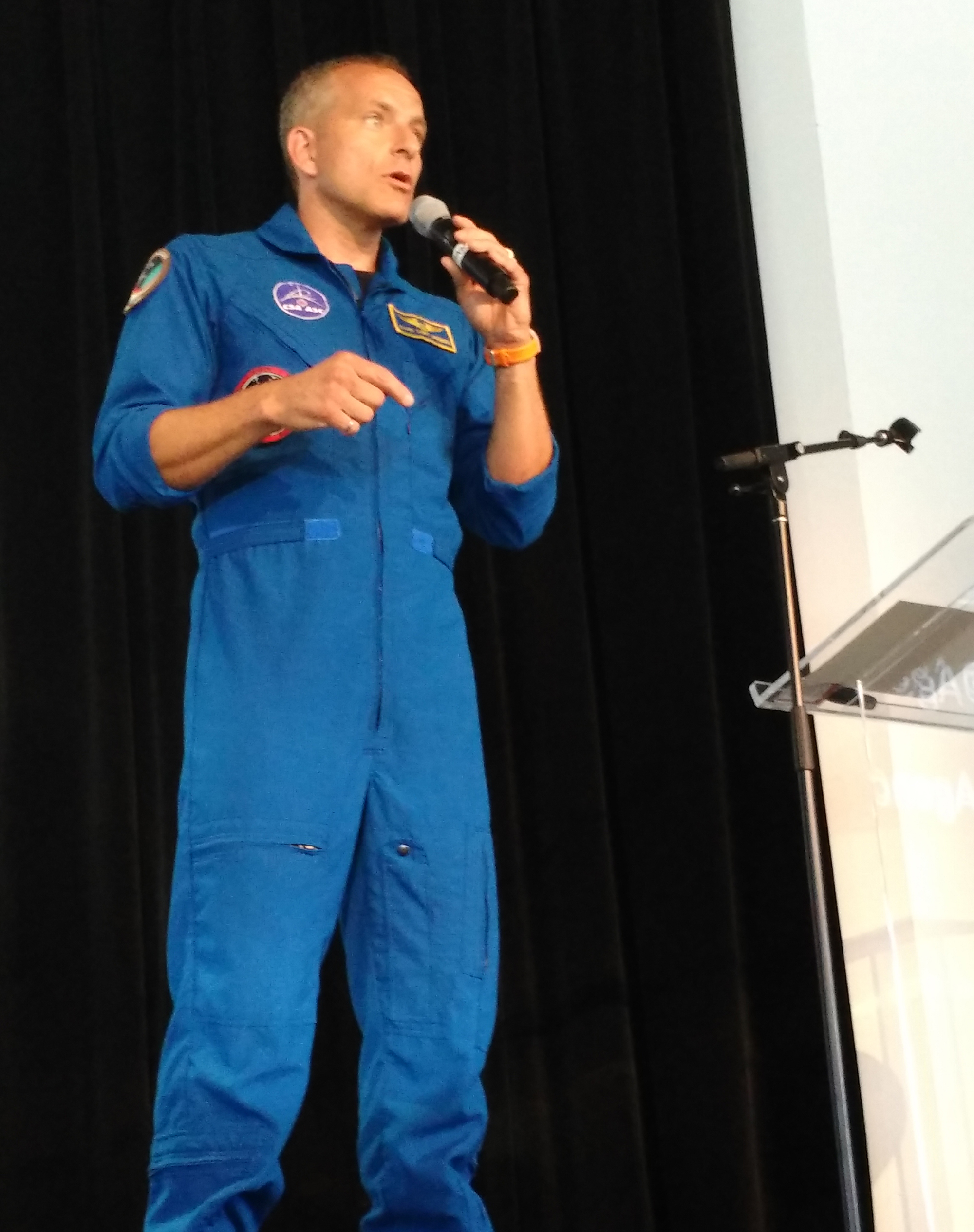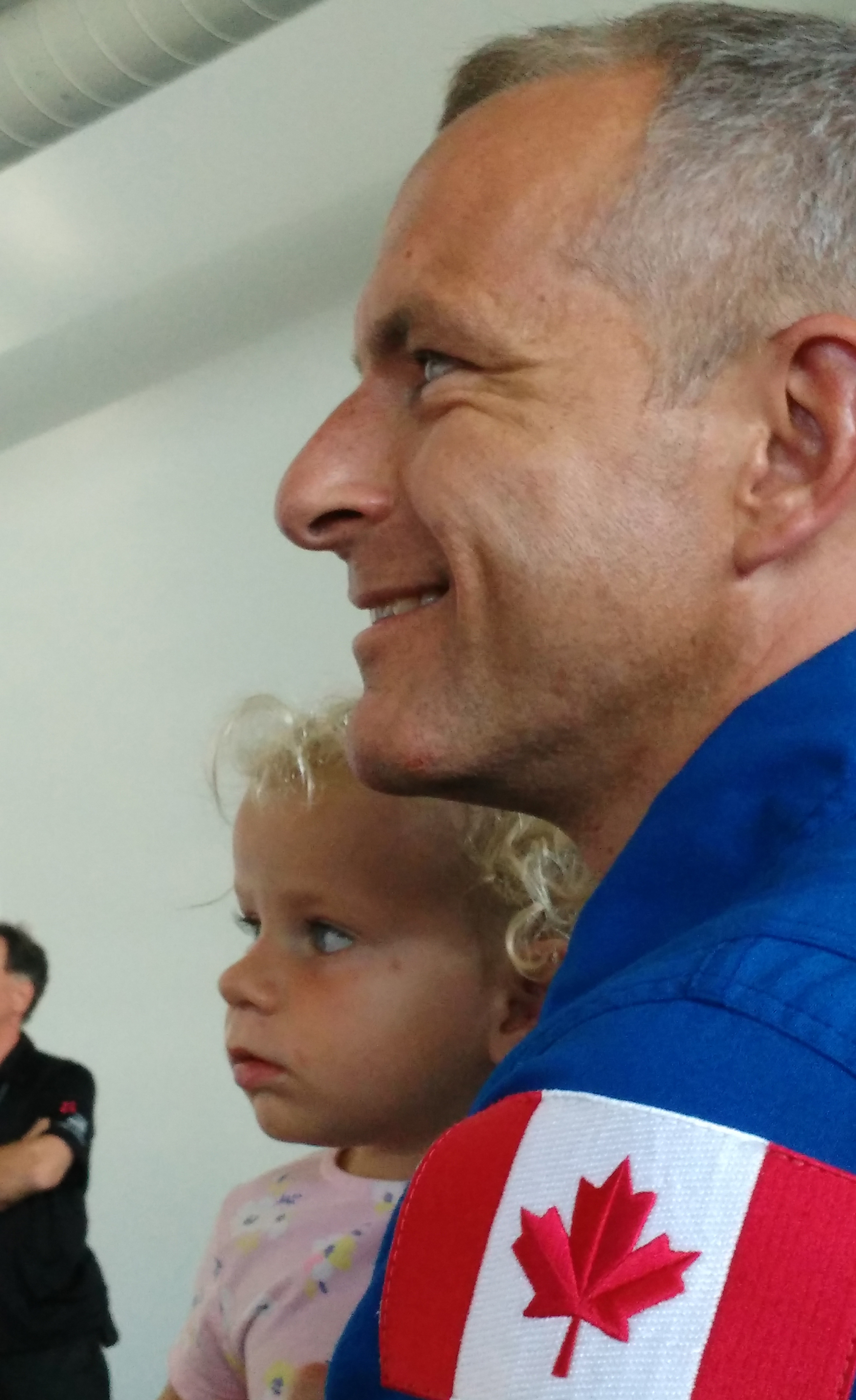Canadian Astronaut Prepares to Launch After a 9-Year Wait

MONTREAL — Lying on his back in front of 300 people on Friday (July 20), Canadian astronaut David Saint-Jacques gently bent his legs and pushed them against his chest.
"Imagine you are an astronaut, sitting like this, and the [rocket] motor is lit," he said, speaking in French to the Montreal Science Centre audience of children and adults. He quickly jumped back on his feet and gestured to a nearby large screen, which was showing a video of a Soyuz spacecraft on top of a Russian Soyuz rocket in Baikonur, Kazakhstan.
Saint-Jacques, 48, paused as the rocket in the video lifted off, surrounding the audience in staccato sound waves. (He just saw a Soyuz lift off for real last month, when he was a backup crewmember for Expedition 56/57.) "It's not very fast, but it accelerates, it accelerates," he continued. "It goes at 2, 3, 4, 20, 25 times the speed of sound." [Touring Baikonur: The Town Behind the Famed Cosmodrome in Kazakhstan]
Soyuz is Saint-Jacques' ticket to space after nine years of waiting on the ground, giving presentations like this all over the country. Canada is a minor partner in the International Space Station program, which assigns "space time" according to how much money or in-kind contributions each partner gives. Its small contribution means astronauts fly rarely; the last one was Chris Hadfield, who commanded the station during Expedition 35 in 2013.

A decade of waiting pays off
Saint-Jacques' visit to the space museum was deliberately timed for July 20, the 49th anniversary of the first human moon landing by Apollo 11 in 1969, museum officials told Space.com. Coincidentally, July 20 also happens to be exactly five months before Saint-Jacques' scheduled Expedition 58 liftoff on Dec. 20.
Canada is quickly waking up to the fact that one of its own will finally fly to space again. Canadian journalists are making so many requests of Saint-Jacques these days that his media team at the Canadian Space Agency did not respond to a Space.com request for an interview in Montreal. The CSA is also hosting a series of "media days" at a Moscow training facility in August, but the requests for TV time with Saint-Jacques there quickly exceeded the agency's capacity to host journalists from other types of media.
Fortunately, the CSA anticipated these demands on his time and generously granted me a half-hour interview in March so that I would have material to draw from during Saint-Jacques' six-month space mission. They also found room for me on a European Space Agency media trip in Kazakhstan in June, arranging multiple interview opportunities with Saint-Jacques while I was there.
Get the Space.com Newsletter
Breaking space news, the latest updates on rocket launches, skywatching events and more!
In the March interview, Saint-Jacques explained that he was assigned the left-hand co-pilot seat in the Soyuz. The assignment is a huge coup for a first-time flyer, and although Saint-Jacques didn't say this, it is probably an acknowledgment of his many years of training with NASA.
"I will be the co-pilot for that launch, so that's a pretty big responsibility," Saint-Jacques said in an unpublished portion of the March phone interview from Moscow, which was in English. "That's why I'm spending pretty much half my time here for the last year and a half, learning to fly the Soyuz. It's my first responsibility. That will be a big thing, and that will be done in 7 minutes."
In that interview, Saint-Jacques spoke in general terms of what he'll be asked to do on the station. That will be about 50 percent science — including a series of Canadian medical and psychological experiments — and 50 percent maintenance. In Kazakhstan in June, CSA space officials told me they are asking NASA to make the most of Saint-Jacques' time in space. This means he may be assigned to demanding tasks such as a spacewalk, or using the station's robotic arm, Canadarm2, to pick up a cargo spacecraft.

"It's best not to make a mistake"
In Montreal, Saint-Jacques swiftly guided his audience through his activities on the space station as his family watched closely. In the front row were his wife, Veronique Morin, and their three small children. One of the boys played with a paper airplane. Occasionally, one of his children shouted to Saint-Jacques on stage. Their father once shouted back playfully to his offspring, in French, "That's right!" The audience laughed.
Saint-Jacques was only 5 or 6 years old when he became aware of the photos taken by Apollo astronauts of Earth from space, he told the audience. He wanted to be an astronaut, but his goal was so far away that it felt like moving toward a distant star, he explained — but he made every step count, thinking of what to study, what career to pursue, even what to eat.
Early in his career, Saint-Jacques held posts as an astrophysicist, an engineer and finally, a medical doctor working in a remote part of northern Quebec. He learned half a dozen languages. And after he and Jeremy Hansen were selected as Canadian astronauts in 2009, Saint-Jacques took part in training expeditions underwater — in caves and in the Arctic — to get used to being in tough environments. Hansen, a former fighter pilot, also helped Saint-Jacques with flight training.
"Flying is for learning how to think as an astronaut," Saint-Jacques explained in French. He said it's very hard to concentrate in a jet plane while wearing an oxygen mask, keeping an eye on the panels and having 10 people speaking in your ear at the same time. "There is no 'pause' button. That [flying] is not a game," he continued. "If you make a mistake, well …" he paused dramatically. "It's best not to make a mistake."
Near the presentation's end, Saint-Jacques knelt and knocked his fist gently against the stage — touching wood for luck as he talked about his scheduled flight. "After all this, we will lift off in five months," he said. "Just the complexity, the difficulty of the space environment, boggles the head."
He spent 10 minutes answering questions from the audience. The last speaker, a small child, stammered for nearly 30 seconds in shyness. "Um, um, what's your favorite color?" the child finally cried out in English, drawing a roar of laughter from the audience.
Saint-Jacques, not missing a beat in promoting spaceflight, told the child seriously that it's probably "sunrise orange" and "the black of space." He left the stage surrounded by well-wishers and fans, quickly disappearing from the auditorium, going on his way to his last few appointments before resuming training.
Follow us @Spacedotcom, Facebook and Google+. Original article on Space.com.
Join our Space Forums to keep talking space on the latest missions, night sky and more! And if you have a news tip, correction or comment, let us know at: community@space.com.

Elizabeth Howell (she/her), Ph.D., was a staff writer in the spaceflight channel between 2022 and 2024 specializing in Canadian space news. She was contributing writer for Space.com for 10 years from 2012 to 2024. Elizabeth's reporting includes multiple exclusives with the White House, leading world coverage about a lost-and-found space tomato on the International Space Station, witnessing five human spaceflight launches on two continents, flying parabolic, working inside a spacesuit, and participating in a simulated Mars mission. Her latest book, "Why Am I Taller?" (ECW Press, 2022) is co-written with astronaut Dave Williams.









